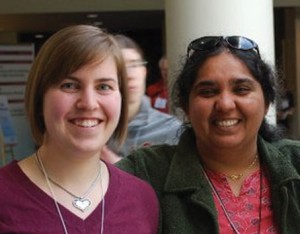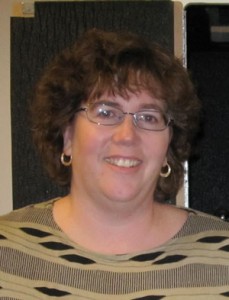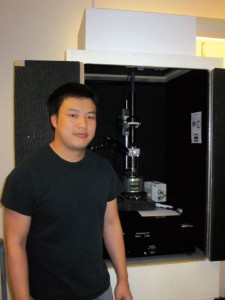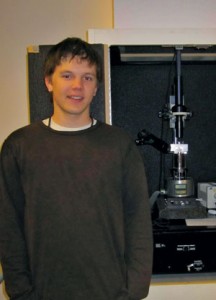Teaming up for investigative research, Colorado College faculty and students are making valuable contributions to science while expanding their educational experience.
“The joy of science is really in doing it,” said Neena Grover, associate professor and chair of CC’s department of chemistry and biochemistry, about why she consistently mentors undergraduates in her laboratory. Grover said, “It’s really about having a sense of wonder. I want students to get an idea of why, as well as how one does research, and to see that they can ask and make progress toward answering complex questions.”
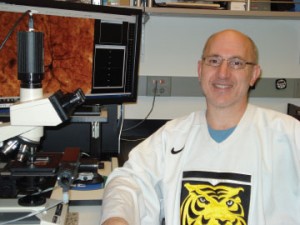
Bob Jacobs, with an image of a cell from an elephant’s cortex projected on the computer screen behind him.
“Our students are capable of this depth and quality,” said Bob Jacobs, CC professor of psychology and co-director of the neuroscience program, which routinely involves students in laboratory studies. “This is about as high-level of research as is available to students, whether undergraduate or graduate,” said Jacobs about recent work that provided the first glimpse into what the elephant cortex is like. Elephants are intelligent animals with complex social and cognitive skills, and “we found out their brains are wired differently than primates,” said Jacobs.
“This opened our eyes to how different brains can be across species… and to how anthropocentric we can be,” expecting elephant brains to be like human ones, said Kaeley Anderson ’09. Anderson, now in medical school at the Oregon Health & Science University in Portland, Ore., co-authored three papers with Jacobs while a neuroscience undergraduate at CC. “In my 18 years at Colorado College, many students have been co-authors on papers, and one other has been a first author. However, Kaeley is the only one to have two first author publications with me,” Jacobs said.
“You don’t get passionate about science by reading it in a book.”
—Associate Professor Neena Grover
Jacobs is careful to pick enthusiastic, dedicated students and then “push them with high expectations,” he said. Each year, he takes such students to meet with other professionals at an international neuroscience meeting.
The process of studying the cortex of the African elephant was slow. Anderson says preparing brain tissue, making slides, and then tracing intricate neurons to get a three-dimensional representation, as well as analyzing and writing up the findings, has given her an appreciation for the amount of work that goes into each and every scientific discovery. She believes these research experiences helped her get into medical school and now inspire her to keep her options open for the future. “I always keep it in the back of my mind that I know this cool technique,” Anderson said.
“We think it’s important for students to have the opportunity to engage in inquiry under the tutelage of a faculty member,” said Victor Nelson-Cisneros, associate dean of the college. Nelson-Cisneros chairs the Dean’s Advisory Committee, which offers grants to support faculty-student studies each summer at CC. Endowments currently allow the faculty-student collaborative research program to provide student wages of $2,500, along with $500 for the faculty member’s research account. Nelson-Cisneros said the undergraduate’s role must be truly collaborative to get funding. “The students are not go-fers, but are involved in all aspects of the research,” and exposed to the intellectual process that characterizes a scholar, he said.
Since 2004, the program has been able to fund from 10 to 19 projects each summer. While the natural sciences account for a majority of the awards, Nelson-Cisneros said the program supports research across the disciplines, routinely including projects from the humanities and social sciences.
“We are giving these students one of their first professional job experiences and part of that is getting paid,” said Kristine Lang, associate professor of physics. She regularly includes CC undergraduates in her research and believes paying them is a priority. Lang applies for either internal or external grants to get such support.
“I try to make opportunities for students in my projects,” said Lang, noting it helps her remain intellectually engaged, moves her research along, and leads to publications. “We are a teaching college and in my opinion, educating them to be scientists includes having them in my lab…It’s not about publishing as many papers as possible,” she said.
“Research experiences are an important part of what students need for success,” Lang said, explaining that it makes students competitive for graduate school and helps them decide what they want to do. But, really, she said, “I want to teach them about thinking.”
“It helped me connect the concrete to the abstract, putting real images to what I’ve studied,” said biology major Andrew Shum ’11, who took initiative on work with Lang while she was on sabbatical. “Truly collaborative, Andrew ran with my idea and developed it into a project,” said Lang about interdisciplinary research using a physics technique to get unique images of bacteria.
For two summers now, a physics major and a biology major have teamed up with Lang and Associate Professor of Biology Phoebe Lostroh to use an atomic force microscope (AFM) to study bacteria. “It’s fascinating what you can see with these microscopes,” said Shum, who is deciding where to attend graduate school as he pursues computational biology and his interest in imaging.
“I learned the scientific community is very supportive of each other,” said Shum, explaining that to come up with appropriate sampling techniques he first read lots of scientific papers, and then contacted a researcher in France for input. In addition, Shum said it was valuable to have the chance to work on writing a grant, manage laboratory details, and interact with his teammate who didn’t have the biology background but had physics expertise.
Being exposed to another area of science is a benefit, agreed Nathan Gustilo ’12 who joined the AFM imaging project the summer after Shum worked on it. A physics major, Gustilo said he is gaining a deeper understanding of biology from this work. “My biology partner and I each get to experience another discipline,” Gustilo said, explaining that it is otherwise difficult to fit in additional high-level coursework while pursuing his physics degree.
“I’ve also learned how important it is in research to follow the data, take it at face value and find out what is happening,” said Gustilo. While the research team set out to achieve high-resolution images of a complex molecular structure on the particular bacteria they are studying, they ended up discovering this bacteria alters its size and shape. Because such dramatic changes are unusual in the bacterial world, the group decided to pursue a more thorough study of the bacteria’s morphology. They plan to write a paper about that work this summer and then continue their study of the molecular structure.
“Students should experience such knowledge production,” said biochemist Grover, explaining that it’s important to see how a statement gets into a textbook, and learn how to find answers rather than rely on others. “In the lab, we see how long it takes to figure something out and that we can’t draw an overall picture from one project,” she said.
Stephanie Furness ’09 said she grew to understand those lessons and more as a biochemistry major who worked with Grover for three and a half years on studies of RNA. “I learned about problem solving, about developing a question, and then figuring out how to answer it,” said Furness. She will enter medical school in the fall, and credits her research experiences at CC with making her a stronger student and thinker. A scientific paper Furniss and Grover co-wrote about the relatively recently discovered RNA called riboswitches is being published in the April issue of RNA, a peer-reviewed journal.
“Now that I dove so deeply into RNA research and RNA thermodynamics, I want to figure out how to implement this in medical practice,” said Furness, adding that research has made her want to be involved in the advancement of medicine.
Summing up the reasons for partnering with students in the laboratory, Grover said, “You don’t get passionate about science by reading it in a book.”
